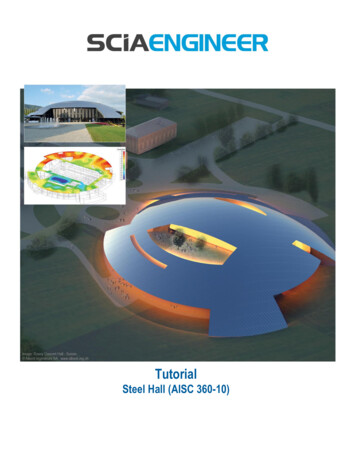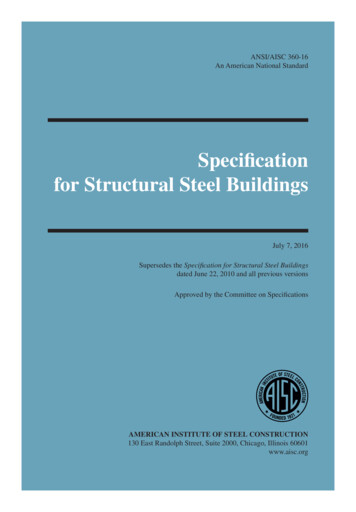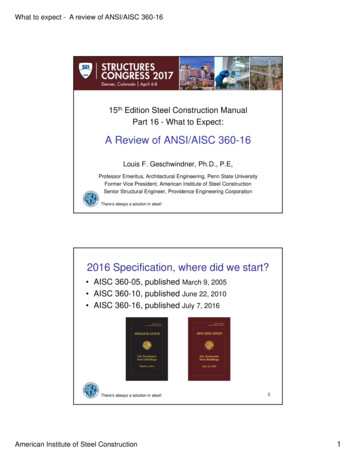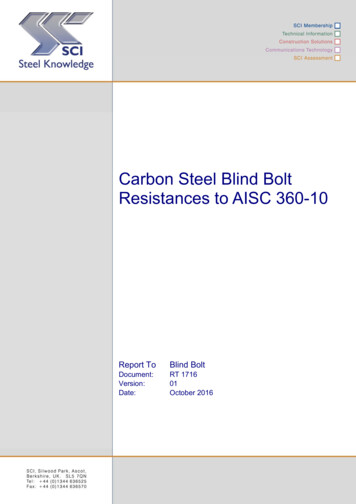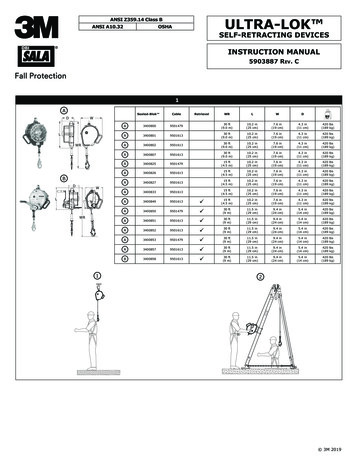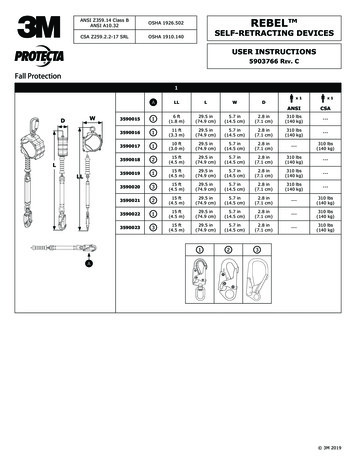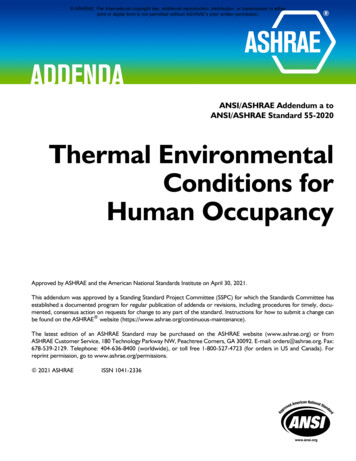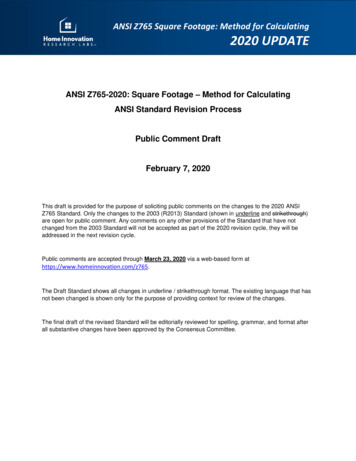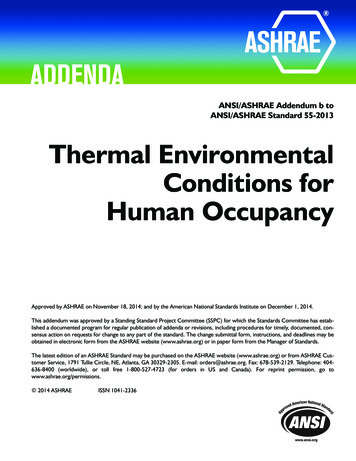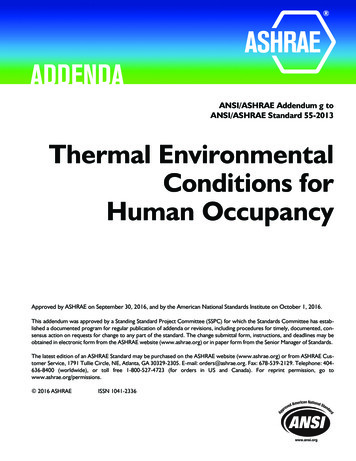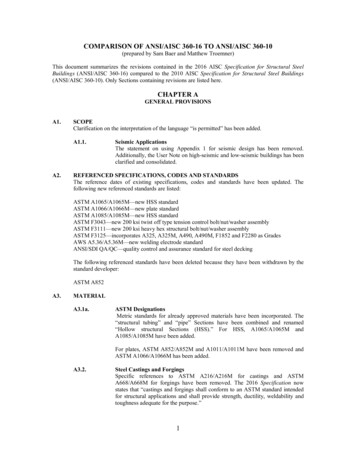
Transcription
COMPARISON OF ANSI/AISC 360-16 TO ANSI/AISC 360-10(prepared by Sam Baer and Matthew Troemner)This document summarizes the revisions contained in the 2016 AISC Specification for Structural SteelBuildings (ANSI/AISC 360-16) compared to the 2010 AISC Specification for Structural Steel Buildings(ANSI/AISC 360-10). Only Sections containing revisions are listed here.CHAPTER AGENERAL PROVISIONSA1.SCOPEClarification on the interpretation of the language “is permitted” has been added.A1.1.A2.Seismic ApplicationsThe statement on using Appendix 1 for seismic design has been removed.Additionally, the User Note on high-seismic and low-seismic buildings has beenclarified and consolidated.REFERENCED SPECIFICATIONS, CODES AND STANDARDSThe reference dates of existing specifications, codes and standards have been updated. Thefollowing new referenced standards are listed:ASTM A1065/A1065M—new HSS standardASTM A1066/A1066M—new plate standardASTM A1085/A1085M—new HSS standardASTM F3043—new 200 ksi twist off type tension control bolt/nut/washer assemblyASTM F3111—new 200 ksi heavy hex structural bolt/nut/washer assemblyASTM F3125—incorporates A325, A325M, A490, A490M, F1852 and F2280 as GradesAWS A5.36/A5.36M—new welding electrode standardANSI/SDI QA/QC—quality control and assurance standard for steel deckingThe following referenced standards have been deleted because they have been withdrawn by thestandard developer:ASTM A852A3.MATERIALA3.1a.ASTM DesignationsMetric standards for already approved materials have been incorporated. The“structural tubing” and “pipe” Sections have been combined and renamed“Hollow structural Sections (HSS).” For HSS, A1065/A1065M andA1085/A1085M have been added.For plates, ASTM A852/A852M and A1011/A1011M have been removed andASTM A1066/A1066M has been added.A3.2.Steel Castings and ForgingsSpecific references to ASTM A216/A216M for castings and ASTMA668/A668M for forgings have been removed. The 2016 Specification nowstates that “castings and forgings shall conform to an ASTM standard intendedfor structural applications and shall provide strength, ductility, weldability andtoughness adequate for the purpose.”1
A4.A3.3.Bolts, Washers and NutsThe following ASTM specifications have been added for bolts: ASTM F3043,ASTM F3111 and ASTM F3125/F3125M. The following ASTM standards havebeen removed for bolts, as they are included as grades in ASTM F3125/3125M:ASTM A325/A325M, ASTM A490/A490M, ASTM F1852 and ASTM F2280.A3.5.Consumables for WeldingAWS A5.36/A5.36M has been added to this Section.STRUCTURAL DESIGN DRAWINGS AND SPECIFICATIONSA User Note has been added to emphasize that there are terminology differences between thisstandard and the AISC Code of Standard Practice, but no conflict is intended.2
CHAPTER BDESIGN REQUIREMENTSB1.GENERAL PROVISIONSA sentence regarding the provision of lateral load resistance and stability through any combinationof members and connections has been removed.B3.DESIGN BASISThis Section has been reorganized.B3.1.Design for Strength Using Load and Resistance Factor Design (LRFD) (wasSection B3.3)B3.2.Design for Strength Using Allowable Strength Design (ASD) (was SectionB3.4)B3.3.Required Strength (was Section B3.1)The wording of this Section has been revised for clarity. A reference to ChapterC has been added for additional requirements. Section B3.7 in the 2010Specification, Moment Redistribution in Beams, has been incorporated into thisSection, and the wording for this paragraph has been revised to clarify that it isapplicable only to indeterminate beams carrying gravity loads.B3.4.Design of Connections (was Section B3.6)This Section has been edited for clarity.B3.4a.Simple Connections (was Section B3.6a)No changes have been made to this Section.B3.4b.Moment Connections (was Section B3.6b)For clarity, the word “initial” has been added to clarify the strength and stiffnessrequirements for an FR connection.B3.5.Design of Diaphragms and Collectors (was Section B3.8)No changes have been made to this Section.B3.6.Design of Anchorages to Concrete (was Section B3.14)The title of this Section has been changed from Anchorage to Concrete.B3.7.Design for Stability (was Section B3.5)This Section has been edited for clarity.B3.8.Design for Serviceability (was Section B3.9)This Section has been edited for clarity.B3.9.Design for Structural Integrity (new Section)This Section addresses integrity requirements for column splices and endconnections to be met when required by the building code.B3.10.Design for PondingThis Section has been edited for clarity. The specific exclusion of roof surfaceswith a slope of ¼ in. per ft. or greater has been removed.B3.11.Design for FatigueThis Section has been edited for clarity.3
B4.B3.12.Design for Fire ConditionsThis Section has been edited for clarity.B3.13.Design for Corrosion EffectsNo changes have been made to this Section.MEMBER PROPERTIESB4.1.Classification of Sections for Local BucklingThis Section has been edited for clarity.B4.1a.Unstiffened ElementsThe definition of nominal dimension has been clarified.B4.1b.Stiffened ElementsIn Section (a), the reference to “formed sections” has been removed and cornerradius has been removed from the definition of h.The prior Section B4.1b(e) was moved to Section B4.1b(f) and new content hasbeen added in Section B4.1b(e) addressing flanges or webs of box sections andother stiffened elements.TABLE B4.1a Width-to-Thickness Ratios:Members Subject to Axial CompressionCompressionElementsCase12345Change in Description****Figures for built up I-shaped sections andchannels have been added to this case toclarify that this case applies to these sections.6Boxes of uniform thickness have beenremoved from this case, they now default toCase 8.7*8*9** No changes have been made.TABLE B4.1b Width-to-ThicknessMembers Subject to nge in Description*******Boxes of uniform thickness removed fromthis case. Moved to Case 21.*4Elements
192021**New case added for flanges of box sections.Previously in Case 17.* No changes have been made.B4.2.Design Wall Thickness for HSSReferences to ERW and SAW production of HSS in both this Section and theUser Note within this Section have been removed. This Section has beenupdated to incorporate the new HSS standards, ASTM A1065/A1065M andASTM A1085/A1085M.B4.3.Gross and Net Area DeterminationB4.3a.Gross AreaNo changes have been made to this Section.B4.3b.Net AreaThe User Note on splice plates has been removed because the requirement wasremoved from Chapter J.B5.FABRICATION AND ERECTIONNo changes have been made to this Section.B6.QUALITY CONTROL AND QUALITY ASSURANCENo changes have been made to this Section.B7.EVALUATION OF EXISTING STRUCTURESNo changes have been made to this Section.5
CHAPTER CDESIGN FOR STABILITYThe major changes to this chapter include: A User Note on alternative methods of analysis in Appendices 1 and 7 has been added. Clarification on what types of initial deformations to be considered has been added.C1.C2.GENERAL STABILITY REQUIREMENTSThe phrase “all other deformations” has been clarified by appending the phrase “all othercomponent and connection deformations.” Consideration of stiffness reduction due to inelasticityhas been expanded to include partial yielding due to residual stresses. Uncertainty in stiffness andstrength has been expanded to include system, member, and connection strength and stiffness. Thedefinition of design in a User Note has been removed because it was moved to the Glossary. Areference to inelastic analysis and the use of Appendix 1 has been moved to Section C1.1.C1.1.Direct Analysis Method of DesignThis Section has been reorganized and expanded to include both elastic andinelastic analysis. Clarification that Sections C2 and C3 are only applicable toelastic analysis has been added. In addition, references to pertinent Sections ofAppendix 1 for inelastic analysis have been added.C1.2.Alternative Methods of DesignThis Section has been reworded to clarify that the methods in Appendix 7 arepertinent only to elastic analysis.CALCULATION OF REQUIRED STRENGTHSThe word elastic has been added for clarity.C2.1.General Analysis RequirementsA User Note on P-Δ only second-order analysis has been revised to clarify thatthe B1 multiplier only applies to the required flexural strength of the member.C2.2.Consideration of Initial ImperfectionsThe intended meaning of initial imperfections has been clarified.A User Note has been reworded to clarify that this Section pertains to systemimperfections only. A reference to Code of Standard Practice Appendix 1,Section 1.2, for analysis of member imperfections has been added.C3.C2.2a.Direct Modeling of ImperfectionsNo changes have been made to this Section.C2.2b.Use of Notional Loads to Represent ImperfectionsLanguage has been added to clarify that notional loads are applied to points ofintersection of members to represent initial system imperfections only.C2.3.Adjustments to StiffnessSection C2.3(b) clarifies that the values for τb determined in this Section are fornon-composite members only. A reference to Section I1.5 for calculation of τbfor composite members has been added. In Equation C2-2b, Py, axial yieldstress, has been replaced by a new variable, Pns, cross-section compressivestrength. Pns differentiates between nonslender and slender element sections, andreferences Section E7 for calculating slender-element section compressivestrength.CALCULATION OF AVAILABLE STRENGTHS6
A statement on bracing requirements for individual members has been moved to a User Note. Thisstatement has also been clarified to reflect that Appendix 6 is not applicable to bracing that is partof the overall lateral force-resisting system.7
CHAPTER DDESIGN OF MEMBERS FOR TENSIOND1.SLENDERNESS LIMITATIONSNo changes have been made to this Section.D2.TENSILE STRENGTHThe reference to Section D3 for determining effective net area has been removed.D3.EFFECTIVE NET AREAThe User Note on bolted splice plates has been removed because the requirement was removedfrom Chapter J.TABLE D3.1Shear Lag Factors for Connections to Tension MembersThis table remains the same with the following exceptions: Plate members and tension membersthat transmit tensile load through longitudinal welds only have been removed from Case 2. Case 4has been expanded to include angles, channels with welds at the heels, tees and W-shapes withconnected elements; the equation for calculating U and the example figure have been updated toaddress longitudinal welds of unequal length; a footnote [a], has been added on how to calculate l.Case 5 has been updated to clarify that the gusset plate is connected through slots in the HSS.D4.BUILT-UP MEMBERSUsage of lacing has been added for clarity on the open-sides of built-up tension members.8
CHAPTER EDESIGN OF MEMBERS FOR COMPRESSIONE1.GENERAL PROVISIONSTABLE USER NOTE E1.1Selection Table for the Application of Chapter E SectionsNo changes have been made to this table.E2.EFFECTIVE LENGTHEffective length is now defined as Lc. A User Note has been added to highlight that Lc can bedetermined by methods other than using the effective length factor, K.E3.FLEXURAL BUCKLING OF MEMBERS WITHOUT SLENDER ELEMENTSUniform compression has been changed to axial compression. Unbraced length has been changedto effective length. The definitions of variables Ag, E, Fe, Fy and r now appear in this Section. TheUser Note has been edited for clarity.E4.TORSIONAL AND FLEXURAL-TORSIONAL BUCKLING OF SINGLE ANGLES ANDMEMBERS WITHOUT SLENDER ELEMENTSThe title of this Section has been changed from Torsional and Flexural-Torsional Buckling ofMembers without Slender Elements. This Section now clearly states that it applies to all doublysymmetric members without slender elements when the torsional unbraced length exceeds thelateral unbraced length and for single angles with b t 0.71 E Fy . Definitions for b and t havealso been added to this Section.The special case in the former Section E4(a) has been removed and is now covered under the newSection E4(b). Section E4(b)(i) has been moved to Section E4(a), Section E4(b)(ii) has beenmoved to Section E4(b) and Section E4(b)(iii) has been moved to Section E4(c).The descriptions above Equations E4-2, E4-3 and E4-4 have been clarified.In Section E4(b), a User Note has been added clarifying the treatment of singly symmetricmembers with the x-axis as the axis of symmetry with regard to the use of this Section.Section E4 Equations2016 SpecChanges in equationE4-1*#Case removed from scription of this equationadded-“flexural constant”.E4-11E4-9*# No equivalent equation in 2016 Specification.* No changes have been made.2010 SpecE4-1E4-2E4-3E4-4E4-5E4-6E4-7E4-8E4-9E4-10A new Section E4(d) has been added clarifying that members with lateral bracing offset from theshear center must use analysis to determine Fe. A User Note has been added referencing adiscussion of this subject in the Commentary.9
E5.SINGLE ANGLE COMPRESSION MEMBERSThis Section has been reworded to clarify when flexural-torsional buckling needs to be considered.Two requirements for use of this Section have been moved to the main body from individualSections E5(a) and E5(b): Lc/r 200 and the ratio between the long leg and short leg dimensionsmust be less than 1.7. The variable rx has been replaced by ra to clarify that it is not the geometricx-axis but rather the axis parallel to the connection The definition of Lc has been added.E6.BUILT-UP MEMBERSE7.E6.1.Compressive StrengthThe User Note is revised to clarify that slip will reduce strength. Section E6.1(a)has been reworded for clarity. In Section E6.1(b), a requirement that theconnecting elements must be Class A or B faying surfaces has been added forclarity.E6.2.Dimensional RequirementsThis Section has been reorganized from paragraphs into a list (a) through (e).MEMBERS WITH SLENDER ELEMENTSThis Section has
Buildings (ANSI/AISC 360-16) compared to the 2010 AISC Specification for Structural Steel Buildings (ANSI/AISC 360-10). Only Sections containing revisions are listed here. CHAPTER A GENERAL PROVISIONS A1. SCOPE Clarification on the interpretation of the language “is permitted” has been added. A1.1. Seismic Applications The statement on using Appendix 1 for seismic design has been File Size: 231KBPage Count: 42People also search foransi aisc 360 16aisc 360 16 bookaisc 360 16ansi aisc 360 10aisc 360 16 pdf
